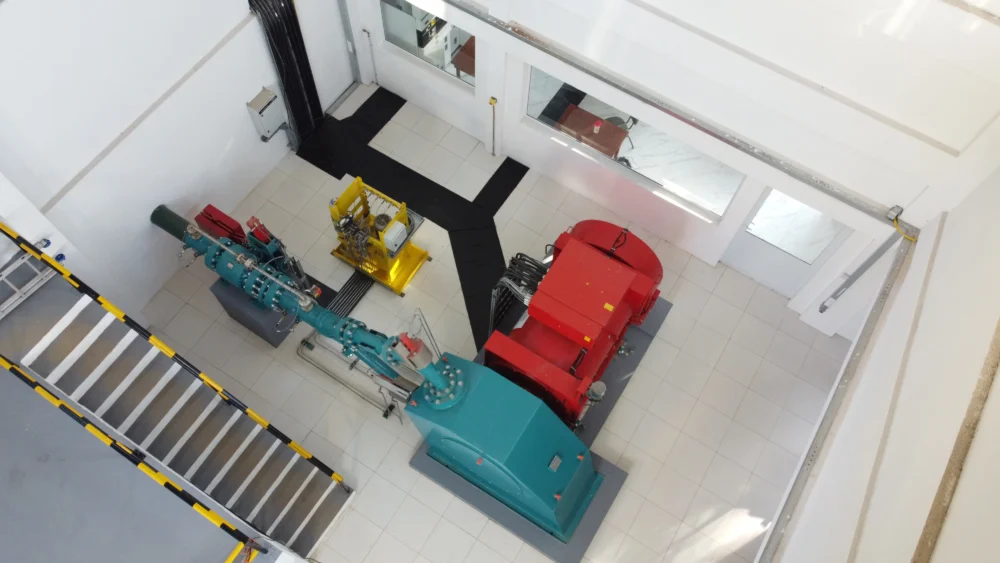Georgetown, July 11, 2025 – Guyana continues to advance its renewable energy transition with the commissioning of the newly constructed 1.5-megawatt (MW) Kumu Hydropower Station in Lethem, Region Nine (Upper Takutu-Upper Essequibo) on Friday.
This new facility is part of a broader national effort to expand renewable energy supply by harnessing the country’s abundant natural resources, strengthening infrastructure and enhancing access to affordable, reliable, and sustainable energy.
The Kumu Hydropower Station, with an installed capacity of 1.5 MW, is expected to generate approximately 9,700 MWh of sustainable electricity annually. This renewable energy will benefit more than 7,000 residents by fostering socio-economic opportunities and stimulating growth for households and businesses across the community, township, and region.
Additionally, it will supply up to 1,500 kilowatts (kW) of power to the grid operated by the Lethem Power Company Incorporated (LMPCI). This will help to reduce LMPCI’s dependence on fossil fuels and cut carbon emissions.
In addition to increasing the installed renewable energy capacity, history was made in December 2024 with the commissioning of the rehabilitated and upgraded 0.7-megawatt (MW) Moco Moco Hydropower Plant.
For the first time, a hydropower plant, solar farm, and diesel generators are working together to supply energy in the region. The recent opening of the Kumu Hydropower Station builds on this progress and further advances the region’s goal of expanding access to sustainable and modern energy supply for the benefit of all the residents.
These energy initiatives are part of a large-scale electrification programme by the Government of Guyana, known as the Small Hydropower Projects. These initiatives aim to bridge the energy gap in hinterland and riverine communities that are not connected to the national utility grid.
The Government received funding for the initiative through a loan from the Islamic Development Bank (IsDB) for the construction of a 1.5 MW Hydropower Station at Kumu and a 0.7 MW Hydropower Plant at Moco Moco, both located in Region Nine (Upper Takutu-Upper Essequibo).
In November 2022, Vidullanka PLC, a Sri Lankan company, was awarded an Engineering, Procurement, and Construction (EPC) contract valued at US$12.85 million to construct the two hydropower plants. The rehabilitation and upgrade of the Moco-Moco Hydropower Plant cost US$3.7875 million, while the construction of the new 1.5MW Kumu hydropower plant cost US$9.0625 million. Cummings Electrical was awarded a US$1.274425 million Contract to construct a 16.84km transmission line from the Kumu plant to interconnect with the Lethem network and to install communication cables on the Moco-Moco transmission line.
Guyana Energy Agency was responsible for overseeing the successful construction and completion of the projects.
The initiative aligns with Guyana’s focus on expanding rural electrification through microgrids, solar photovoltaic (PV) systems with batteries, run-of-river and river dam hydro, and hybrid renewable energy systems.
The Kumu hydro plant is located on the Kumu River on the Kanuku Mountains and includes a weir, diversion system, forebay, penstock, powerhouse, tail water canal, step-up substation, transmission line and administration building.
Like to recently commissioned 0.7MW Moco-Moco hydropower plant, The Kumu plant is also a run-of-river type design that has a small weir rather than a dam or reservoir. While a dam stores water for release when needed, the weir allows for continuous natural flow while diverting some water for power generation. Run-of-river (RoR) hydropower plants have significantly lower environmental impacts when compared to dam-based projects.
Unlike dams, these types of plants avoid large reservoirs, helping to preserve aquatic ecosystems, minimize habitat loss, and maintain natural river flows. They do not create stagnant water that generates methane, have less impact on water quality and sediment flow, require less land, and do not displace communities and cultural sites.
Additionally, the combined capacity of the 1.5 MW Kumu Hydropower Station, 0.7 MW Moco Moco Hydropower Plant and the 1 MW solar photovoltaic (PV) farm has the potential to supply Lethem and surrounding communities with most of their energy from renewable sources.
Hydropower remains one of Guyana’s most important sources of renewable electricity, with an installed capacity of approximately 8.5 gigawatts (GW). The country has made significant strides in expanding its hydropower resources to supply energy to the regional grids and to Hinterland communities.
One of the key energy projects being pursued is the construction of the 165 MW Amalia Falls Hydropower Plant (AFHP). By harnessing its extensive river networks, Guyana aims to promote initiatives that meet and exceed the country’s growing energy needs.
The country is diversifying its energy mix, underpinned by the goals outlined in the Low Carbon Development Strategy (LCDS) 2030, to increase the share of renewables to include hydropower, solar, wind and natural gas. The overarching goal is to add 500 MW of new capacity to power residential and commercial users. This effort also supports the nation’s progress toward achieving Sustainable Development Goal (SDG) 7, which focuses on modernizing energy systems, enhancing energy and food security, while contributing to climate resilience.
Currently, Guyana is well on its way to becoming a leading example of sustainable energy development that benefits people across the country.

